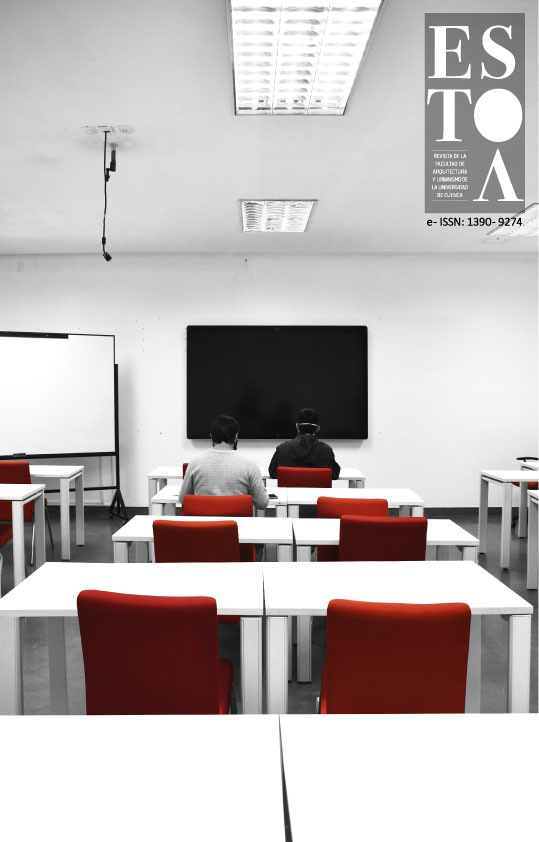Dynamic evaluation of solar light control. Proposals in a modern architecture library in Santiago
DOI:
https://doi.org/10.18537/est.v009.n018.a11Keywords:
library, solar control, daylight, dynamics metric, TAU architectsAbstract
The sensitive approach to the local climatic environment was check, from the envelope in the modern architecture, at the Ruy Barbosa library, designed by the Chilean TAU office architects. It was built early at the seventies decade with a modular solar control system in precast concrete, with checked favorably performances according to methods of dynamic evaluation of natural light measured in ASE1000,250h, and in the illuminances range 300 lux - 3000 lux. We proposed five models. It was concluded that Ase1000,250h approached us to criteria related to light comfort, resulting in the horizontal model (Mh) highly recommended in the restoration of light comfort, being in the range of illuminances evaluated above 75% of the sensors of the analyzed grid. The mixed East model (Mm-o), obtained positive performances, even though the perpendicular sun on the facade in the morning gave it high interior solar access to the study room.
Downloads
References
Bellia L, De Falco F. y Minichiello F. (2013). Effects of solar shading devices on energy requirements of standalone office buildings for Italian climates. Applied Thermal Engineering (54), 190-201.
Brainard, G. C., Hanifin, J. P., Greeson, J. M., Byrne, B., Glickman, G., Gerner, E. y Rollag, M. D. (2001). Action Spectrum for Melatonin Regulation in Humans: Evidence for a Novel Circadian Photoreceptor. The Journal of Neuroscience. 21(16), 6405–6412. doi:10.1523/JNEUROSCI.21-16-06405.2001
Cáceres, O. (2007). La arquitectura de Chile independiente. Concepción, Chile: Ediciones Universidad del Bío Bío.
Comisión Asesora de Bibliotecas y Documentación. CABID. (2003). Estándares para bibliotecas universitarias chilenas. (2ª ed.). Chile, Valparaíso: Ediciones Universitarias de Valparaíso. Universidad de Valparaíso.
Eliash, H. y Moreno, M. (1989). Arquitectura y modernidad en Chile, 1925-1965. Una realidad múltiple. Chile, Santiago: Ediciones Universidad Católica de Chile.
Esquivias, P. M., Muñoz, C. M., Acosta, I., Moreno, D. y Navarro, J. (2016). Climate based daylight analysis of fixed shading devices in an open plan office. Lighting Research and Technology. 48(2), 205-220. doi: 10.1177/1477153514563638
Fuentes, P. (2011). La revista Auca, entre 1965 – 1973: un aporte disciplinar al problema habitacional y la participación social. De Arquitectura. 23(1), 20-23. Recuperado de https://revistas.uchile.cl/index.php/RA/article/view/26896
Heschong, L. (2012). Daylight Metrics. PIER Daylighting Plus Research Program. Sacramento, USA: Heschong Mahone Group.
IES (Illuminating Engineering Society). (2012). Spatial Daylight Autonomy (sDA) and Annual Sunlight Exposure (ASE). New York, USA: IES. LM-83-12.
Nabil, A. y Mardaljevic, J. (2005). Useful daylight illuminance: a new paradigm for assessing daylight in buildings. Lighting Research Technology. 37(1), 41-59. doi: 10.1191/1365782805li128oa
Nabil, A. y Mardaljevic, J. (2006) Useful daylight illuminances: A replacement for daylight factors. Energy and Buildings, 38 (7) 905–930.
doi: 10.1016/j.enbuild.2006.03.013
Norma Chilena de Electricidad 4/2003. Recuperado de
https://www.leychile.cl/Navegar?idNorma=226558
Mardaljevic, J. (2009). Daylight, Indoor Illumination and Human Behavior.New York, USA. Springer Science+Business Media.
Mardaljevic J., Heschong L., y Lee E. (2009). Daylight metrics and energy savings. Lighting Research and Technology, (41), 261–283. doi:10.1177%2F1477153509339703
Martín, C. (2008). Bibliotecas universitarias: concepto y función. Los CRAI. Madrid, España: Editorial Murilla Lería.
Monteoliva, J. M. y Pattini, A. (2013). Iluminación natural en aulas: análisis predictivo dinámico del rendimiento lumínico-energético en climas soleados. Ambiente Construido, 13(4), 235-248. doi: 10.1590/S1678-86212013000400016
Pérez, R., Seals, R., y Michalsky, J. (1993). All weather model for sky luminance distribution. Preliminary configuration and validatio. Solar Energy, 50(3), 235-245. doi:10.1016/0038-092X(93)90157-J
Piderit, M. B., Cauwerts, C. y Díaz, M. (2014). Definition of the CIE standard skies and application of high dynamic range imaging technique to characterize the spatial distribution of daylight in Chile. Revista de la construcción 13(2), 22-30. Recuperado de http://revistadelaconstruccion.uc.cl/index.php/rdlc/article/view/446/37
Préndez, M., Carvajal, V., Corada, K., Morales, J., Alarcón, F. y Peralta, H. (2013). Biogenic volatile organic compounds from the urban forest of the Metropolitan Region, Chile. Environmental Pollution, 183, 143-150. doi: 10.1016/j.envpol.2013.04.003
Reinhart, C. F., Mardaljevic, J., y Rogers, Z. (2006). Dynamic daylight performance metrics for sustainable building design. Leukos, 3(1), 1-25. doi: 10.1582/LEUKOS.2006.03.01.001
Reinhart, C. F. & Walkenhorst, O. (2001). Dynamic Radiance Based Daylight Simulations for a full-scale test office with outer venetian blinds. Energy and Buildings 33(7), 683–697. doi: 10.1016/S0378-7788(01)00058-5.
Reinhart, C. F. y Wienold, J. (2011). The daylighting dashboard e A simulation-based design analysis for daylit spaces. Building and Environment, 46, 386-396. doi: 10.1016/j.buildenv.2010.08.001
Reinhart, C. F. (2014). Daylighting Handbook I. Fundamentals Designing with the Sun. Boston. USA: Building Technology Press.
Reinhart, C. F. (2018). Daylighting Handbook II. Daylight Simulations. Dynamic Facades. Boston, USA: Building Technology Press.
Rockcastle, S. y Andersen, M. (2014). Measuring the dynamics of contrast & daylight variability in architecture: A proof-of-concept methodology. Building and Environment 81, 320-333. doi: 10.1016/j.buildenv.2014.06.012
Roldán, J. A. (2017). Daylight performance depending on the atrium geometry conditions within buildings in Santiago, Chile. S. Roaf (Chair), Passive Low Energy Architecture. Design to Thrive. 33rd. PLEA International Conference. Edimburgh, Scottland: NCEUB. Recuperado de https://flore.unifi.it/retrieve/handle/2158/1094227/315869/R_G_PLEA2017.pdf
Silva, L. (2013). Arquitectura moderna en Chile a través de la obra de TAU arquitectos, 1954-1971. (Tesis Doctoral). Universidad Politécnica de Madrid, Madrid, España. Recuperado de http://oa.upm.es/22390/
USGBC (United States Green Building Council). (2013). LEED Reference Guide for Building Design and Construction. Version 4. Recuperado de http://www.usgbc.org/.
Wurtman, R. J. (1975). The effects of light on the human body. Scientific American, 233 (1): 69-77.
Zambrano, P. y Prado, L. (2016). Simulación de iluminación natural en oficinas: comparación de los niveles lumínicos considerando la estación, color y hora: Implicaciones para la eficiencia visual. Estoa. Revista de la Facultad de Arquitectura y Urbanismo de la Universidad de Cuenca, 8(5). 59-71. doi: 10.18537/est.v005.n008.06
Published
How to Cite
Issue
Section
License
The Journal declines any responsibility for possible conflicts derived from the authorship of the works that are published in it.
The University of Cuenca in Ecuador conserves the patrimonial rights (copyright) of the published works and will favor the reuse of the same ones, these can be: copy, use, diffuse, transmit and expose publicly.
Unless otherwise indicated, all contents of the electronic edition are distributed under a Creative Commons Attribution-NonCommercial-ShareAlike 4.0 International License.




